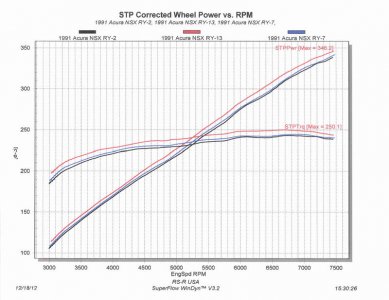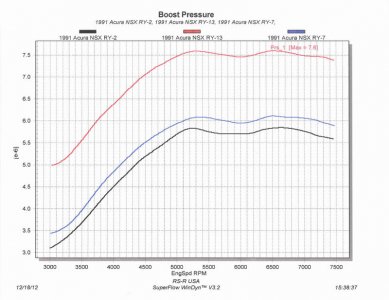I figure my 4000th post should be special. So my Christmas present for you all is below.
This is a follow-up to our friend L_Rao's thread. I'll be updating this more later with details.
Here's one of the 17+ dyno runs yesterday. We were at the RSR R&D facility pretty much all day long being as meticulous as possible. I have several minutes worth of data logs from my Zeitronix data logger if anyone is interested.
<iframe width="560" height="315" src="http://www.youtube.com/embed/jJdPBmwfXEg" frameborder="0" allowfullscreen=""></iframe>
I'll let the dyno speak for themselves. Please ask questions!
We picked the 2nd most conservative result from multiple runs from each test group.
RY-2 = Baseline (Test Group 1)
RY-7 = Ran Up in the CTSC only (Test Group 2)
RY-13 = Ran Up in CTSC and Engine (Test Group 3)
My bragging rights: With a correction factor applied peak hp will be approx at 365whp on Bisimoto's dyno on the low boost CTSC with my own RRFPR and Boost-a-pump tune.
As heatsoak set in the dyno curves started getting funky as the car was pulling more and more timing while the IATs were getting hot. After the Ran Up and the increased boost and temps my car was starting to run lean and basically freaking the F out. With a tune we should be seeing way more than 10hp up top i'm quite sure. IATs were already in the 180F+ after the 3rd consecutive run. I need to install my meth and FIC asap.

The increased slippery'ness of the motor causes boost to build up faster. We frankly did not expect this. Also, my data logger uses a digital map sensor directly at the intake manifold. My baseline boost read 7lbs flat rising to 8.9lbs (this is from the "Low Boost" pulley). RS*R boost sensor was connected to one of my vacuum lines which read a different boost pressure below. The important part is the incremental gain you see below. We can probably attribute the actual boost pressure to sensor calibration issues.

BTW.. I'm in the process of putting together a group buy for this product on an introductory basis. It's good stuff. Admins: I won't be doing the GB. More on this later..


This is a follow-up to our friend L_Rao's thread. I'll be updating this more later with details.
Here's one of the 17+ dyno runs yesterday. We were at the RSR R&D facility pretty much all day long being as meticulous as possible. I have several minutes worth of data logs from my Zeitronix data logger if anyone is interested.
<iframe width="560" height="315" src="http://www.youtube.com/embed/jJdPBmwfXEg" frameborder="0" allowfullscreen=""></iframe>
I'll let the dyno speak for themselves. Please ask questions!
We picked the 2nd most conservative result from multiple runs from each test group.
RY-2 = Baseline (Test Group 1)
RY-7 = Ran Up in the CTSC only (Test Group 2)
RY-13 = Ran Up in CTSC and Engine (Test Group 3)
My bragging rights: With a correction factor applied peak hp will be approx at 365whp on Bisimoto's dyno on the low boost CTSC with my own RRFPR and Boost-a-pump tune.
As heatsoak set in the dyno curves started getting funky as the car was pulling more and more timing while the IATs were getting hot. After the Ran Up and the increased boost and temps my car was starting to run lean and basically freaking the F out. With a tune we should be seeing way more than 10hp up top i'm quite sure. IATs were already in the 180F+ after the 3rd consecutive run. I need to install my meth and FIC asap.
The increased slippery'ness of the motor causes boost to build up faster. We frankly did not expect this. Also, my data logger uses a digital map sensor directly at the intake manifold. My baseline boost read 7lbs flat rising to 8.9lbs (this is from the "Low Boost" pulley). RS*R boost sensor was connected to one of my vacuum lines which read a different boost pressure below. The important part is the incremental gain you see below. We can probably attribute the actual boost pressure to sensor calibration issues.
BTW.. I'm in the process of putting together a group buy for this product on an introductory basis. It's good stuff. Admins: I won't be doing the GB. More on this later..


Last edited:






